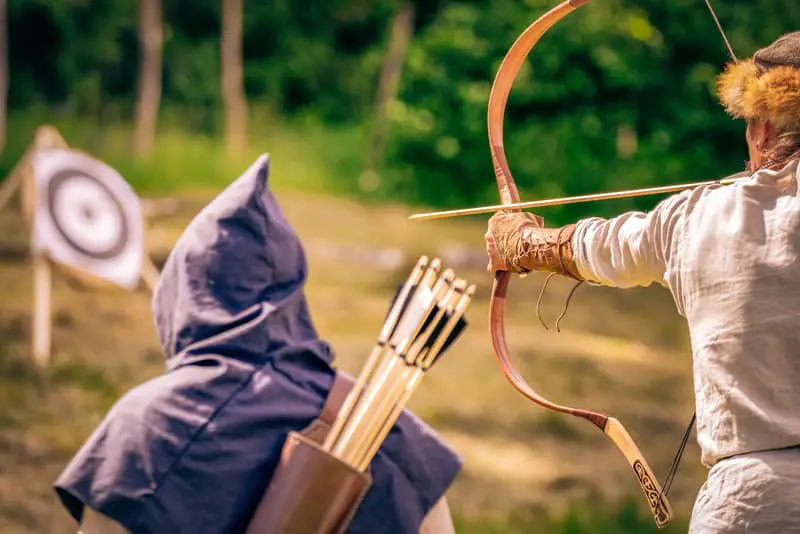
Archery is the practice, sport, and art of bows to shoot arrows. Today, archery is more of a competitive sport and recreational activity, but in medieval times, it was used for combat and hunting. The word ‘archery’ comes from the Latin word ‘arcus’, which literally translates to ‘bow’.
To fully understand medieval archery, we will discuss the following:
Contents
Brief History of Archery
According to evidence, archery was first practiced around 10,000 BC during the Paleolithic period, making it one of the oldest sports in the world.
During this phase, the Egyptians and the neighboring Nubian countries used bow and arrow archery for the purpose of warfare and hunting.

Ramesses II (1279–1213 BC) depicted with bow and arrow, during battle.
addesia via Pixabay
In China, the Shang dynasty (1766-1027 BC) was the first to use archery. At that time, a war chariot was made up of three men: archer, lancer, and driver.
The ensuing Zhou dynasty conducted sports archery tournaments that were attended by the nobles in court.
In the sixth century, China introduced Japan to the art of archery, and it ended up having a tremendous influence on archery’s later techniques and etiquettes.
Japan had a martial art known as Kyujutsu (the art of the bow), which is now known as Kyodo (way of the bow).
The Japanese follow modern Kyodo as a way to uplift themselves physically, morally, and spiritually.
During the Greco-Roman period, archery was mainly used for hunting or other personal exploits instead of as a means of warfare.
For centuries, the Middle East dominated archery techniques and equipment. The bows developed by the Parthians and Assyrians enabled the Mongols to conquer large territories of Asia and Europe, while it allowed the Turks to defend themselves against the Crusaders.
Compared to an English yew bow, the Asian and Turkish bows were significantly more effective – the record shot using a Turkish flight bow was a whopping 900 yards.
Types of Medieval Archer Weapons
Depending on the nation, time, and purpose, medieval archers used a range of weapons, most of which were:
Longbow

Recreation of a medieval archer using a longbow
Image by Alessandro Squassoni from Pixabay
The longbow was designed to be tall – around as tall as the user itself – enabling the archer to take a long draw.
The limbs of a longbow are relatively narrow so that they are D-shaped or circular in cross-section. Compared to the bow and arrow, the longbow was able to launch arrows faster.
However, at the same time, it required extra skill and training. A skilled longbow man was able to release around 10-13 arrows per minute.
From the 14th century until the introduction of firearms, the longbow was the primary weapon for English armies.
The weapon was particularly effective against opponents who used plate armors, and a longbowman could shred the armor of a knight at ranges that exceeded 250 yards.
Bowstring
A bowstring is a series of strings that connects the ends of the bow stave and launches the arrow. A good bowstring should be strong, lightweight, and resistant to water and abrasion.
It was usually made of three strings of hemp.
Crossbow
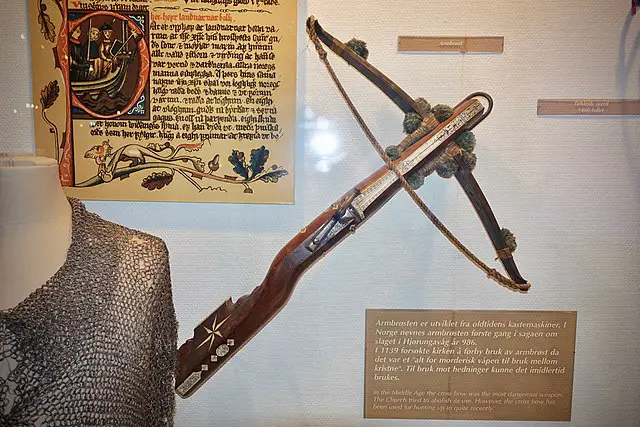
A middle ages Crossbow, in an exhibition of the Armed Forces Museum of Norway
Wolfmann, CC BY-SA 4.0, via Wikimedia Commons
A ranged weapon, a crossbow uses an elastic launching device that works like the bow. The crossbow was easy to use and did not require much training or skill.
However, it could only shoot a couple of bows per minute – although it had a decent range of between 400 and 500 metres.
The crossbow was usually used by lower-ranked archers. It consisted of a prod (a bow-like assembly), which is mounted horizontally on a main frame, referred to as the tiller.
You held a tiller like you would hold the stock of a long gun.
Types of Arrowheads Used by Medieval Archers

Medieval Arrowheads
Photo 177745113 © Esebene – Dreamstime.com
Fire arrows: One of the first forms of weaponized gunpowder, fire arrows have been in use since the 9th century. The fire arrow earned its name from the Chinese term ‘huojian,’ which literally translates to ‘fire arrow.’ Fire arrows were not very popular due to their low effectiveness – the speed of the arrow would often extinguish the flame.
Metal-tipped: Before the advent of metal-tipped arrows, archers mainly used arrowheads made up of stone. The American-Indians introduced metal-tipped arrowheads, which were far more effective and durable than their stone counterparts. Iron and brass were the two metals normally used for preparing arrowheads.
Broadheads: These are flat and wide-bladed points and were used primarily for hunting. Such a point had more surface, enabling the archers to make the arrow fly differently than other arrowhead types. A broadhead creates major wounds inside its target.
Blunt points: Another arrow type normally used for hunting, a blunt point is used for targeting and killing small game with the use of blunt force.
Field points: These tapered and sharpened bullet points can be used for hunting and target archery. These point types are considered to be more ‘target saving’ when used for target archery, as they do not cover the kind of distance that a bullet point would.
Bullet points: This arrowhead type is also used for both hunting and target archery but is less destructive than field points. Like a bullet end, the end of a bullet point is shaped like a pointed dome. The diameter of the arrow shaft should be larger or the same as the diameter of the arrow tip. Else, it will affect the aerodynamics of the arrow and cause snagging in its targets.
Training of a Medieval Archer
Archery was crucial for the Lords in the Middle Ages. Archery was considered to be a lot more than just a sport, and men of lower classes were required to practice archery by law.
The first medieval archery law was passed in 1252, according to which, all Englishmen between the ages of 15 and 60 had to equip themselves with bows and arrows.
There was a specific area dedicated to archery training, called a ‘Butt’. The effectiveness of archery can be estimated by the fact that, in the Battle of Crecy in 1346, a total of 2000 French soldiers and officials were killed by the longbow archers, while the English army suffered only 50 casualties.
This explains why archery was so important for the officials and kings during the medieval times.
A Medieval Archers Involvement in Battle
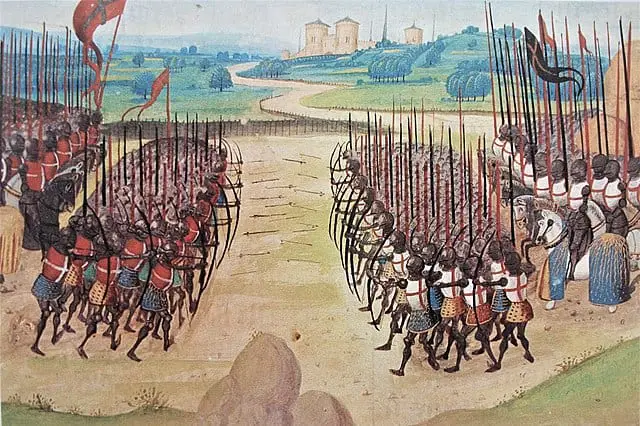
Battle of Agincourt (1415)
See page for author, Public domain, via Wikimedia Commons
Naturally, medieval archers were essential to every battle. The ease of use associated with a crossbow meant that an archer needed no assistance in operating it.
On the other hand, an archer operating a longbow required cover, and a long shield was also often used during the battle.
Famous Medieval Archer Battles
The Battle of Hastings was one of the most famous medieval battles where archers had a crucial role to play. This battle concluded with King Harold of England dying at the hands of the Norman King William, which marked the beginning of a new era in England.
During this battle, the medieval archers started ahead of the army and commenced the action.
The Battle of Agincourt was another famous battle where longbowmen had a particularly important contribution.
The Most Famous Medieval Archers
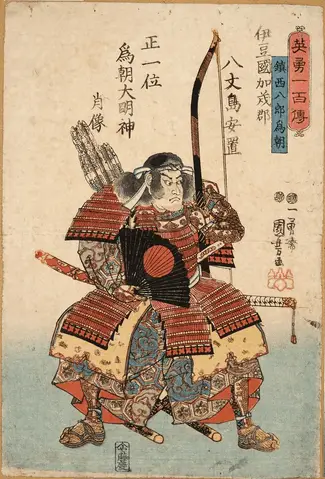
Portrait of Minamoto no Tametomo
Kuniyoshi Utagawa, 歌川国芳, Public domain, via Wikimedia Commons
Minamoto no Tametomo (1139-1170): A Samurai who participated in the 1156 Hogen Rebellion. Legend says that Tametomo once sunk a Taira ship using a single arrow. It is also believed that his left hand was 15 centimeters longer than his right one, allowing him to draw longer bows and make more powerful shots.
Nasu no Yoichi (1169-1232): This Samurai fought for the Minamoto clan during the Genpei war that lasted from 1180 to 1185. When the Heike were defeated in the Battle of Yashima, the Minamoto clan chased them on horses, but the Heike were able to flee in their boats. While awaiting the right wind, Heike posed a challenge for the Minamoto archers by placing a fan on the mast of their ship. Nasu no Yoichi stood on his horse and was able to strike the fan with the very first arrow.
Yue Fei (1103-1142): He was a military general in China. He won his very first archery competition by shooting nine consecutive arrows through the bullseye that was placed at a distance of 240 paces.
Bonus archer from modern times
Fred Bear (1902-1988): Alongside being a television host and author, Bear was a bow hunter and manufacturer. He was also the first president of Michigan’s oldest archery club – Detroit Archers. Bear is seen by many as one of the pioneers of bow hunting.
Medieval Archery Tournaments

Medieval archery tournament recreation
3centista via Pixabay
While there is evidence that suggests the existence of archery tournaments in China more than 3,000 years ago, the modern sport of archery most likely initiated in England during the 14th century.
As mentioned previously, during this time, the longbow was considered to be the English armies’ most important weapon.
This was primarily due to the longbow’s long-range abilities, which were absent from both the spear and the sword.
The importance of archery can be judged by the fact that, during 1363, a royal decree obliged every Englishman to practice archery during Sundays and other holidays.
At the time, there was a range of shooting types, some of which evolved to become part of the modern sport of archery. These were:
Clout shooting: A target was placed flat (not vertically), and the arrows were arched high in the air with the objective of striking the target. The aim was to land the bow as close to the target as possible. This shooting style is still popular today and is often practiced with traditional bows.
Roving marks: In this shooting style, archers were made to shoot at a target, only to shoot at another target but from the location of the previous target. Many people consider this to be the oldest type of competitive archery, and it was even practiced by Henry VIII.
Butt shooting: Butts (made up of turfs of earth) held the targets that the archers were supposed to shoot at. The contemporary Olympic shooting is based on this shooting style.
Archery was one of the sports in the second Olympics Games conducted in 1900. However, since the rules varied so much between nations, the sport was eventually dropped in 1920 until 1972, when it was restored.
This restoration only happened after the rules for archery were standardized by the bodies governed by the Federation International de Tir l’Arc.
Clothing/Fashion of Medieval Archers

Young Medieval archer with chain shirt
Photo 78800508 © Claudia Evans – Dreamstime.com
Although the clothing of medieval archers varied between countries, nations, and times, a typical archer would wear the following:
- A sallet and kettle helmet for the head.
- Multiple armors for the body (plate coats, brigandine, maille shirts under doublets, and sleeveless gambeson).
- Poleyn (used for the knees).
- Rebrace and Vambrace (lower and upper cannons for the arms).
- Chain voiders.
Types of Armor Used by Medieval Archers

Medieval Archer Armor
Photo 179347217 © Sergei Pivovarov – Dreamstime.com
The armors used by medieval archers typically fell into the following three categories:
- Armor made using fabric, leather, or a combination of both. This kind of armor was often reinforced using felt or quilting.
- Mail which was prepared using interwoven rings of steel or iron.
- Rigid armor prepared using metal, wood, plastic, horn, or any other resistant or tough material.
The third armor type was the one that protected the European knights during the middle ages.
This armor was made up of large iron or steel plates that were connected with internal leathers and loosely closed rivets to equip the wearer with maximum mobility and freedom of movement.
Equipment Used by Medieval Archers

Quiver with arrows on medieval archer’s back
Photo 132628950 © Georgy Dzyura – Dreamstime.com
Apart from arrowheads, bows, and other weapons, archery involved the use of several other equipment, mainly for protective purposes. The most important medieval archery equipment was:
Quiver: A quiver is a container that holds arrows, darts, bolts, or javelins. It could either be carried on a bow, the ground, or the archer’s body, depending upon the shooting type and the archer’s preference. Traditionally, quivers were made using furs, wood, leather, or other natural materials. Modern quivers are usually made of plastic or metal.
Thumb ring: Thumb ring was an equipment piece designed specifically to protect the thumb during archery. This ring was made up of stone, leather, bone, wood, horn, metal, ivory, antler, plastic, ceramics, or glass, and fit over the thumb end and resting at the outer edge of the outer joint. A flat area usually extended from the ring, intending to protect the thumb pad from the bowstring, and was sometimes supplemented with a leather extension.
Finger tab: Also known as an archer tab, a finger tab is a small synthetic or leather patch designed to protect an archer’s fingers from the bowstring. It is strapped or attached in some way to the archer’s hands.
Bracer: A bracer is also called an arm guard and is a sheath or strap usually made up of leather, plastic, or stone. This sheath or strap covers the inside surface of an archer’s bow-holding arm.
The Legend of Robin Hood in English Folklore
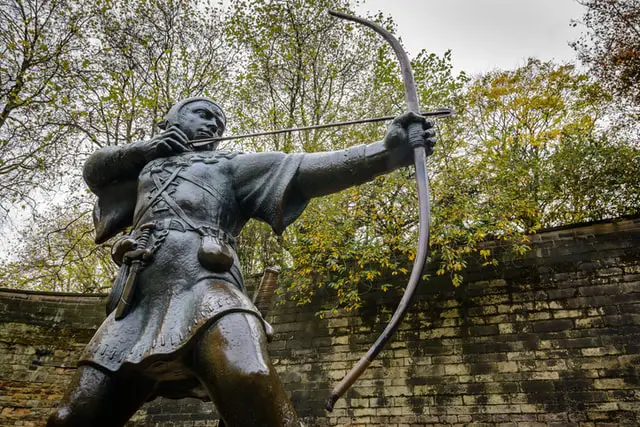
Robin Hood statue, Nottingham, England
Photo by Steve Harvey on Unsplash
A legendary heroic outlaw, Robin Hood initially made his way into English folklore and was later featured in film and literature.
Legends say that Robin Hood was a highly skilled swordsman and archer. Certain versions of the legend depict him as belonging to a noble family, while other versions say that he fought the Crusaders before making his return to England and finding out that all his lands had been taken by the sheriff.
Some of the oldest versions portray him as a member of the yeoman class. It is believed that Robin Hood robbed the rich and gave to the poor.
Medieval Archer FAQs
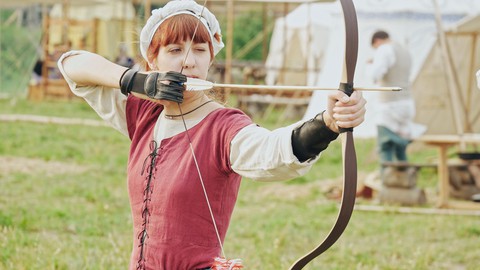
Medieval archer training
Photo 157736976 © Alex0marina – Dreamstime.com
Ans) The medieval archers were quite accurate, considering that they were able to kill their enemies at incredible ranges. According to examination records and military manuals, Asian archers consistently struck their man-sized targets with both their right and left hands from a range of up to 70 meters from the saddle – and twice that on foot.
Ans) In the Middle Ages, archery was a vital skill for the Vikings, used for both hunting and war. According to the Assize of 1252, the law required English yeomen (an earlier version of the militia), to maintain their skills and consistently practice archery. Throughout the Middle Ages, skilled archers were highly prized and valued.
Ans) Every archer carried a sheaf (a set of 24 arrows). These arrows were either pushed through the archers’ belts or carried in a quiver. Some soldiers used crossbows to fire bolts (short arrows). The defenders picked off the attackers using crossbows or bows, firing from behind the battlements or from Arrowslits.
Ans) According to Viking legends, an archer could shoot an arrow over 1500 yards (1350 meters) – however, this range sounds doubtful.
In modern times, the farthest that a heavy war arrow has been shot using a heavy war bow is just over 300 yards (270 meters). Joe Gibbs was the person to pull it off, using a 170-pound (75-kg) pull yew longbow. For the English Longbow, the modern record stands at 450 yards (412 meters).
Ans) Medieval archers had the following characteristics and qualities:
1. Intense concentration and focus.
2. Clear mind.
3. Excellent balance and concentration.
4. Excellent distance-judging abilities.
5. High muscle strength.
6. Commitment.
Their training started as soon as they could walk and talk. Initially, they would be given small and weak bows to practice with, and every year, the bow continued to increase in strength and size. By the time they were grown up, they were pulling hundred-pound war bows. Practicing every Sunday was mandatory, and every country fair had an archery contest that all men took part in.
Top 5 Movies Based on Archery
- The Legend of Robin Hood: In King Richard’s absence, Prince John and the Norman Lords started to oppress the Saxon masses. As an outlaw leader commanding the rebel guerilla army, a Saxon lord decides to fight back.
- Troy: The movie revolves around the Greek force assault on Troy, and the chronicles the destinies of all the men involved.
- Conquest: A young man, equipped with magical arrows and bows, leaves on a mystical adventure to a mystical land with the purpose of cleansing it of all evil. In the process, he joins hands with an outlaw in order to try and defeat an evil witch who wants to use the magic bow for her ill intentions.
- Gladiator: A corrupt general murdered a young boy’s family and sent the boy to slavery. Years later, that young boy, now a former Roman General, decides to get his revenge.
- The Hunger Games – Catching Fire: After their 74th Hunger Games lead to a rebellion in the Panem Districts, Peeta Mellark and Katniss Everdeen become the targets of the Capitol.
Summary
To conclude, archery was a vital skill in medieval times, and medieval archers were some of the most respected and sought-after people. We hope that this guide helped you gain valuable information about medieval archery and the lives of medieval archers.
References:
- https://www.dkfindout.com/us/history/castles/archers/#:~:text=Each%20archer%20carried%2024%20arrows%2C%20called%20a%20sheaf.&text=Archers%20carried%20their%20arrows%20in,or%20from%20behind%20the%20battlements.
- https://www.quora.com/How-far-would-medieval-archers-shoot
- https://guycounseling.com/archery-man-skills/
- https://en.wikipedia.org/wiki/Quiver
- https://en.wikipedia.org/wiki/Thumb_ring
- https://en.wikipedia.org/wiki/Finger_tab
- http://www.historyofarchery.com/archery-facts/famous-archers/
- http://www.medieval-life-and-times.info/medieval-life/medieval-archer.htm
- https://ohiohistorycentral.org/w/Metal_Arrowheads
- https://www.medievalchronicles.com/medieval-people/medieval-military/medieval-archers/
- https://worldarchery.org/news/93847/brief-history-archery-1#:~:text=The%20earliest%20evidence%20of%20archery,(1766%2D1027%20BC).
- https://www.topendsports.com/sport/archery/history-competition.htm#:~:text=While%20there%20is%20recorded%20evidence,English%20army’s%20most%20important%20weapon.
- https://www.britannica.com/topic/armour-protective-clothing
- https://targetcrazy.com/archery/resources/types-of-arrows/
- https://www.quora.com/How-early-were-medieval-archers-trained-to-use-a-bow
Header image courtesy: 152089538 © Jaroslav Moravcik – Dreamstime.com

Great article
It is stated in the article that a Longbow will “shred” armour at 250 metres. This is a fallacy that took hold after the 1944 movie “Henry V” (Azincourt). A long bow with a draw weight of 160lb, which is very high, will not pierce plate armour at ten metres nor did they arc arrows at a distance. It was a close quarter shooting keeping the arrows flat and hard hitting.